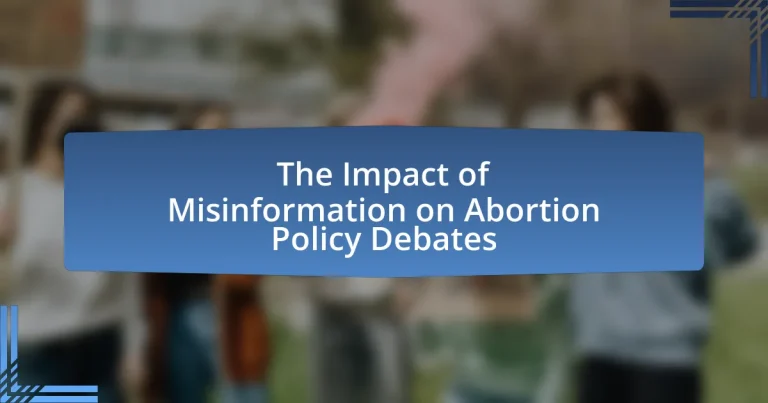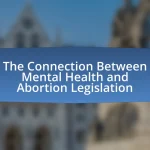The article examines the significant impact of misinformation on abortion policy debates, highlighting how distorted facts shape public perception and influence legislative outcomes. It identifies common sources of misinformation, such as social media and biased media reporting, and discusses how these inaccuracies affect individual beliefs and contribute to polarization in discussions about abortion. The article emphasizes the importance of understanding misinformation in policy discussions, as it can lead to misguided legislative decisions and restrict access to reproductive healthcare. Additionally, it outlines strategies for combating misinformation, including fact-checking, media literacy initiatives, and community engagement, to promote informed public discourse on abortion policies.
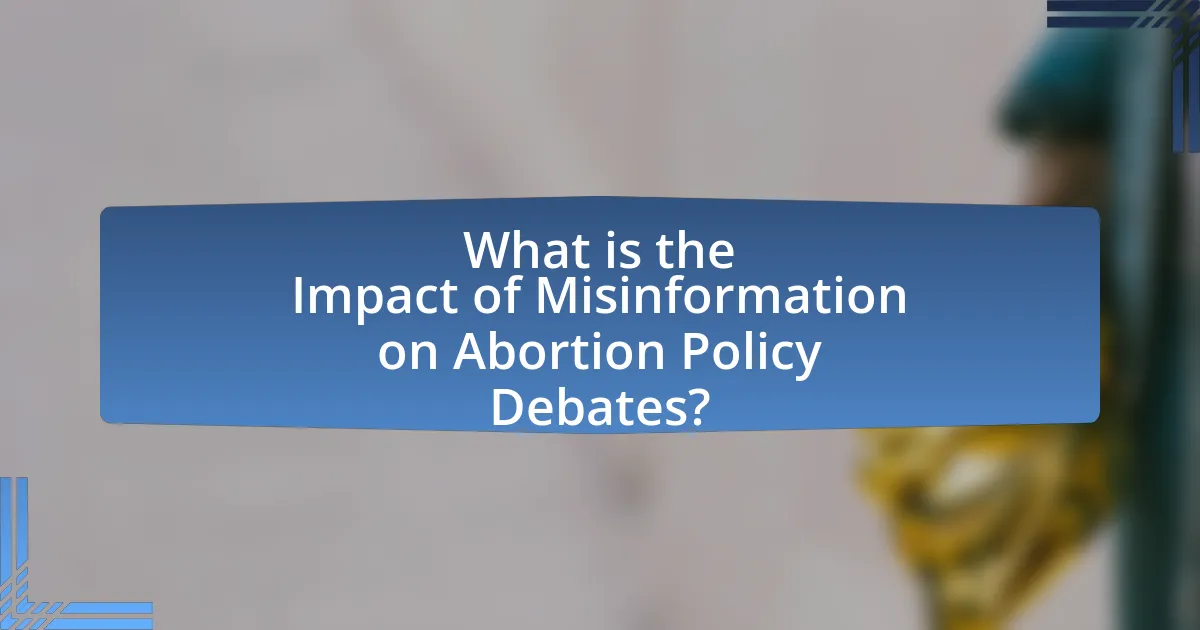
What is the Impact of Misinformation on Abortion Policy Debates?
Misinformation significantly distorts abortion policy debates by shaping public perception and influencing legislative outcomes. For instance, false claims about the health risks of abortion can lead to increased support for restrictive laws, as seen in various states where misleading statistics have been used to justify policy changes. Research from the Guttmacher Institute indicates that misinformation can create a climate of fear and misunderstanding, ultimately affecting women’s access to reproductive healthcare. This manipulation of facts undermines informed decision-making among policymakers and the public, leading to policies that may not reflect the actual needs or rights of individuals.
How does misinformation shape public perception of abortion policies?
Misinformation significantly shapes public perception of abortion policies by distorting facts and creating misconceptions. For instance, false claims about the health risks of abortion or exaggerated statistics regarding its prevalence can lead to heightened fear and stigma surrounding the procedure. Research from the Guttmacher Institute indicates that misinformation can influence public attitudes, resulting in increased support for restrictive policies. This manipulation of information often sways public opinion, leading to legislative changes that may not reflect the actual needs or views of the population.
What are the common sources of misinformation regarding abortion?
Common sources of misinformation regarding abortion include social media platforms, political rhetoric, and biased or inaccurate media reporting. Social media often amplifies false narratives due to the rapid spread of unverified information, with studies indicating that misinformation can reach millions within hours. Political rhetoric frequently distorts facts to sway public opinion, as seen in various campaigns that misrepresent medical data or the implications of abortion laws. Additionally, biased media reporting can perpetuate myths by selectively presenting information or failing to fact-check claims, contributing to a misinformed public discourse surrounding abortion.
How does misinformation influence individual beliefs about abortion?
Misinformation significantly influences individual beliefs about abortion by shaping perceptions and attitudes based on false or misleading information. For instance, studies have shown that exposure to inaccurate claims about abortion procedures or health risks can lead individuals to adopt more negative views towards abortion. A survey conducted by the Guttmacher Institute found that misinformation regarding the safety of abortion procedures correlates with increased stigma and opposition to abortion rights. This demonstrates that when individuals encounter misleading information, it can distort their understanding and reinforce pre-existing biases, ultimately affecting public opinion and policy debates surrounding abortion.
Why is understanding misinformation crucial in abortion policy discussions?
Understanding misinformation is crucial in abortion policy discussions because it shapes public perception and influences legislative outcomes. Misinformation can lead to misconceptions about the safety and implications of abortion, which may result in policies that do not reflect scientific evidence or public health needs. For instance, studies have shown that false claims about abortion risks can sway public opinion and create barriers to access, as seen in various states where restrictive laws have been enacted based on misleading information. Accurate information is essential for informed decision-making by policymakers and the public, ensuring that discussions are grounded in facts rather than falsehoods.
What role does misinformation play in legislative decision-making?
Misinformation significantly influences legislative decision-making by shaping public opinion and altering the perceptions of policymakers. When inaccurate information circulates, it can lead to misguided beliefs about the implications of legislation, as seen in the context of abortion policy debates where false claims about health risks and fetal development often emerge. Research indicates that legislators may rely on public sentiment, which is swayed by misinformation, leading to the enactment of laws that do not reflect accurate scientific understanding or the needs of constituents. For instance, a study published in the journal “Health Affairs” highlights how misinformation surrounding abortion procedures can result in restrictive laws that do not align with medical evidence, ultimately affecting women’s access to healthcare.
How can misinformation affect the outcomes of abortion-related referendums?
Misinformation can significantly skew the outcomes of abortion-related referendums by shaping public perception and influencing voter behavior. For instance, false claims about the health risks of abortion or misleading statistics regarding its prevalence can create fear and misconceptions among voters. Research conducted by the Pew Research Center indicates that misinformation can lead to polarized opinions, ultimately affecting turnout and the decisions made at the polls. In the 2020 election cycle, various studies showed that voters exposed to misinformation were more likely to support restrictive abortion measures, demonstrating a direct correlation between misinformation and referendum outcomes.
What are the consequences of misinformation on abortion policy debates?
Misinformation significantly undermines abortion policy debates by distorting public perception and influencing legislative outcomes. For instance, false claims about the safety of abortion procedures can lead to increased stigma and fear, impacting women’s access to necessary healthcare services. Additionally, misinformation can mobilize opposition groups, resulting in stricter regulations and laws that do not reflect the actual medical consensus or public opinion. Studies have shown that states with higher levels of misinformation regarding abortion often enact more restrictive policies, which can lead to negative health outcomes for women.
How does misinformation contribute to polarization in abortion discussions?
Misinformation significantly contributes to polarization in abortion discussions by creating and reinforcing extreme viewpoints. When individuals encounter false or misleading information about abortion, such as exaggerated claims about its health risks or the implications of legislation, they often adopt more rigid stances. Research indicates that exposure to misinformation can lead to increased emotional responses and a decreased willingness to engage in constructive dialogue, as seen in studies published in journals like “Political Behavior” by researchers such as Lewandowsky et al. This dynamic fosters an environment where individuals are more likely to align with like-minded groups, further entrenching their beliefs and reducing the potential for compromise or understanding across differing perspectives.
What impact does misinformation have on women’s health and rights?
Misinformation significantly undermines women’s health and rights by perpetuating false narratives about reproductive health, leading to harmful policies and stigmatization. For instance, inaccurate claims about the safety of abortion procedures can deter women from seeking necessary medical care, resulting in increased health risks. A study published in the American Journal of Public Health found that misinformation surrounding abortion can lead to a 30% increase in negative health outcomes for women who are misinformed about the procedure. Furthermore, misinformation can influence public opinion and legislative decisions, restricting access to reproductive health services and infringing on women’s rights to make informed choices about their bodies.
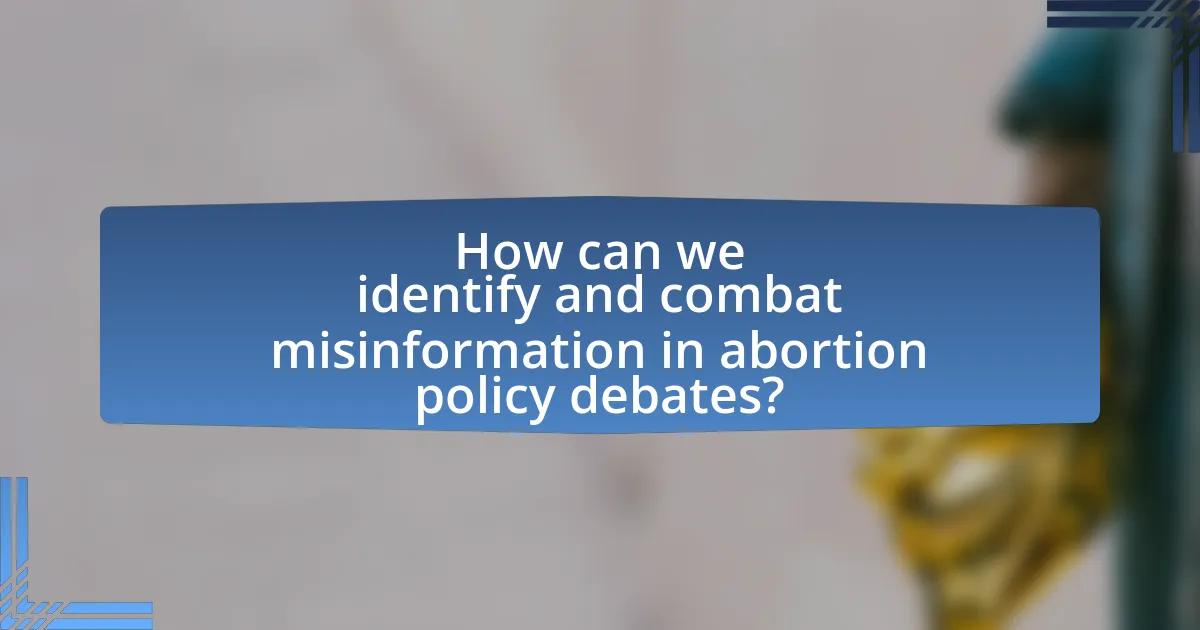
How can we identify and combat misinformation in abortion policy debates?
To identify and combat misinformation in abortion policy debates, it is essential to implement fact-checking mechanisms and promote media literacy among the public. Fact-checking organizations, such as PolitiFact and FactCheck.org, analyze claims made in public discourse, providing evidence-based assessments that clarify the accuracy of statements regarding abortion policies. Additionally, educational initiatives that enhance media literacy can empower individuals to critically evaluate sources of information, discern credible data, and recognize biased narratives. Research indicates that misinformation can significantly influence public opinion and policy decisions; for instance, a study published in the journal “Health Affairs” found that exposure to false information about abortion can lead to misconceptions that affect legislative outcomes. By combining fact-checking with media literacy efforts, stakeholders can effectively reduce the spread of misinformation and foster informed discussions on abortion policy.
What strategies are effective in debunking misinformation about abortion?
Effective strategies for debunking misinformation about abortion include providing accurate information, utilizing credible sources, and engaging in open dialogue. Accurate information can be disseminated through educational campaigns that clarify misconceptions, such as the safety of abortion procedures, which are supported by data from the World Health Organization indicating that legal abortions are safe and complications are rare. Utilizing credible sources, such as peer-reviewed studies and expert opinions, helps to establish trust and authority in the conversation. Engaging in open dialogue allows for addressing concerns and questions directly, fostering a more informed public discourse. Research from the American Psychological Association highlights that direct engagement with individuals who hold misconceptions can lead to a better understanding of the facts surrounding abortion.
How can fact-checking organizations contribute to accurate information dissemination?
Fact-checking organizations contribute to accurate information dissemination by verifying claims and providing evidence-based assessments of information. These organizations employ rigorous methodologies to evaluate the truthfulness of statements made in public discourse, particularly in contentious areas like abortion policy debates. For instance, a study by the Pew Research Center found that fact-checking can significantly reduce the spread of misinformation by correcting false claims and enhancing public understanding. By publishing their findings, fact-checking organizations help to clarify misconceptions and promote informed decision-making among the public and policymakers.
What role do social media platforms play in addressing misinformation?
Social media platforms play a critical role in addressing misinformation by implementing fact-checking mechanisms, content moderation policies, and user reporting systems. These platforms, such as Facebook and Twitter, have established partnerships with independent fact-checkers to verify claims and label false information, thereby reducing its spread. For instance, Facebook reported that its fact-checking efforts led to a 50% reduction in the sharing of false information during the 2020 U.S. elections. Additionally, social media companies have developed algorithms to prioritize credible sources and limit the visibility of misleading content, which is essential in the context of sensitive topics like abortion policy debates.
Why is media literacy important in the context of abortion misinformation?
Media literacy is crucial in the context of abortion misinformation because it empowers individuals to critically evaluate the information they encounter. This skill enables people to discern credible sources from unreliable ones, which is essential given that studies show a significant amount of misinformation surrounding abortion can influence public opinion and policy decisions. For instance, a 2020 report by the American Public Health Association highlighted that misinformation can lead to increased stigma and misunderstanding about abortion, affecting access to care. By fostering media literacy, individuals are better equipped to challenge false narratives and advocate for informed discussions on abortion policies.
How can education initiatives improve public understanding of abortion issues?
Education initiatives can improve public understanding of abortion issues by providing accurate information and fostering critical thinking skills. These initiatives can include comprehensive sex education programs, community workshops, and accessible online resources that clarify medical, legal, and ethical aspects of abortion. For instance, studies show that states with comprehensive sex education have lower rates of unintended pregnancies and abortions, indicating that informed individuals make better decisions regarding reproductive health. Furthermore, educational campaigns that address common misconceptions can reduce stigma and promote informed discussions, ultimately leading to more nuanced public opinions on abortion policies.
What resources are available to help individuals discern credible information?
Individuals can utilize fact-checking websites, academic journals, and government resources to discern credible information. Fact-checking websites like Snopes and FactCheck.org provide verified information on various topics, including abortion policies. Academic journals, such as those found in databases like JSTOR or PubMed, offer peer-reviewed studies that present evidence-based findings. Government resources, including official health department websites and legislative documents, provide authoritative information on abortion laws and policies. These resources collectively help individuals navigate misinformation and make informed decisions regarding abortion policy debates.
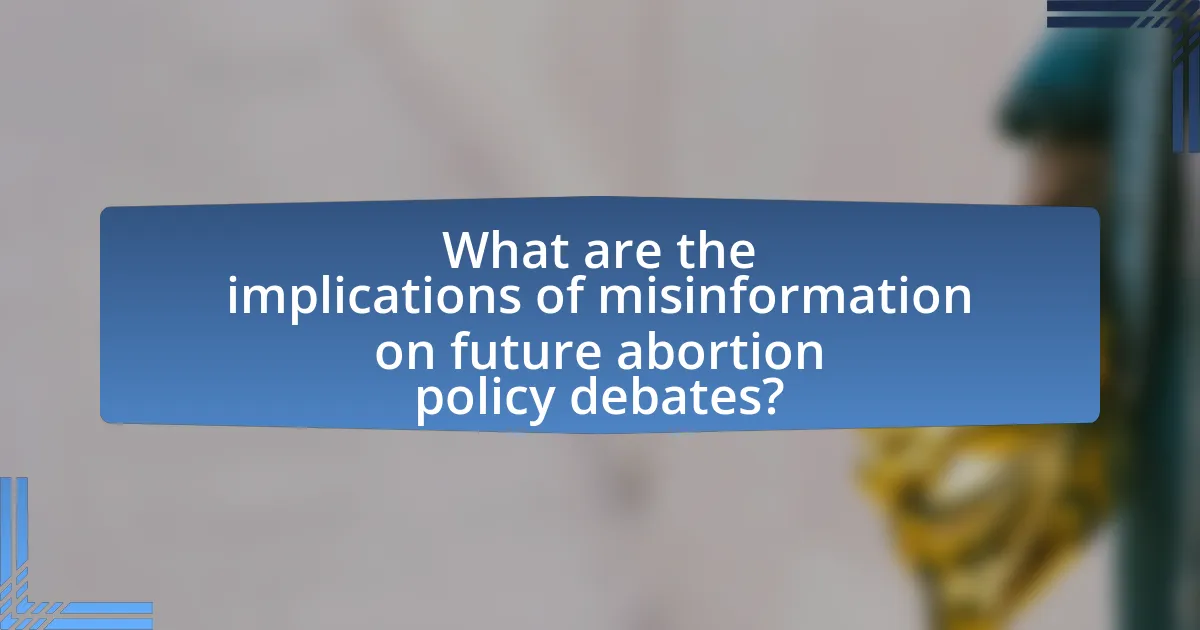
What are the implications of misinformation on future abortion policy debates?
Misinformation significantly undermines future abortion policy debates by distorting public perception and influencing legislative outcomes. When inaccurate information circulates, it can lead to polarized opinions among the public and lawmakers, making it difficult to reach consensus on policies. For instance, studies have shown that misinformation about the safety and effects of abortion can sway public opinion, as seen in the 2016 election cycle where false claims about abortion procedures gained traction, impacting voter attitudes and legislative proposals. This distortion can result in the enactment of restrictive laws based on unfounded fears rather than evidence-based research, ultimately affecting access to reproductive healthcare.
How might misinformation evolve in the context of changing abortion laws?
Misinformation may evolve in the context of changing abortion laws by adapting to new legal frameworks and public sentiments surrounding the issue. As laws shift, misinformation can proliferate through social media and other platforms, often exploiting emotional narratives or misrepresenting scientific data to sway public opinion. For instance, during significant legal changes, false claims about the implications of those laws—such as exaggerated health risks or misleading statistics about abortion rates—can emerge, as seen in various studies that highlight the rapid spread of inaccurate information during contentious policy debates. This evolution is often fueled by partisan agendas, where misinformation is tailored to resonate with specific ideological groups, thereby complicating the public’s understanding of the actual legal and health implications of abortion laws.
What trends are emerging in the spread of misinformation about abortion?
Emerging trends in the spread of misinformation about abortion include the proliferation of false narratives on social media, the use of emotionally charged language to manipulate public perception, and the targeting of specific demographics with tailored misinformation campaigns. Research indicates that platforms like Facebook and Twitter are increasingly used to disseminate misleading information, with studies showing that false claims about abortion procedures and health risks are shared more widely than factual content. For instance, a 2021 study published in the journal “Health Communication” found that misinformation about abortion was often framed in a way that incited fear, leading to increased polarization in public opinion and influencing policy debates.
How can policymakers anticipate and respond to misinformation challenges?
Policymakers can anticipate and respond to misinformation challenges by implementing proactive communication strategies and fostering media literacy among the public. Proactive communication involves providing clear, accurate information about abortion policies and related health issues to counteract false narratives. For instance, studies show that misinformation can significantly influence public opinion and policy decisions, as seen in the 2016 U.S. presidential election where false claims about healthcare impacted voter perceptions. Additionally, fostering media literacy equips individuals with the skills to critically evaluate information sources, reducing the spread of misinformation. Research from the Pew Research Center indicates that media literacy programs can enhance individuals’ ability to discern credible information, thereby mitigating the effects of misinformation on public discourse and policy debates.
What best practices can be implemented to mitigate misinformation in abortion debates?
To mitigate misinformation in abortion debates, implementing fact-checking initiatives is essential. Fact-checking organizations can verify claims made in public discourse, providing accurate information to counter false narratives. For instance, the Poynter Institute’s PolitiFact has effectively debunked numerous misleading statements regarding abortion statistics and policies, enhancing public understanding. Additionally, promoting media literacy programs can empower individuals to critically evaluate sources of information, reducing the spread of misinformation. Research indicates that individuals with higher media literacy are less susceptible to believing false claims, as shown in studies conducted by the Stanford History Education Group. Engaging healthcare professionals in public discussions can also provide authoritative perspectives, as their expertise lends credibility to the information shared.
How can advocacy groups effectively communicate accurate information?
Advocacy groups can effectively communicate accurate information by utilizing evidence-based messaging and leveraging multiple communication channels. Evidence-based messaging ensures that the information shared is grounded in reliable research and data, which enhances credibility. For instance, studies show that messages supported by statistics from reputable sources, such as the Guttmacher Institute, significantly improve public understanding of abortion-related issues. Additionally, employing diverse communication channels, including social media, community outreach, and partnerships with trusted organizations, allows advocacy groups to reach a broader audience and counter misinformation effectively. This multi-faceted approach not only disseminates accurate information but also engages the community in informed discussions about abortion policy.
What role can community engagement play in reducing misinformation impact?
Community engagement plays a crucial role in reducing the impact of misinformation by fostering informed dialogue and promoting critical thinking among individuals. Engaged communities can collaboratively identify and address false narratives, as evidenced by initiatives like the “Media Literacy Now” campaign, which has shown that educational programs increase individuals’ ability to discern credible information. Furthermore, community-led fact-checking efforts, such as those implemented by local organizations during the COVID-19 pandemic, have effectively countered misinformation by providing accurate data and resources. These collective actions not only empower individuals but also create a culture of accountability, making it more difficult for misinformation to proliferate within the community.
